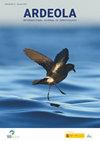为纪念
IF 1.2
4区 生物学
Q2 ORNITHOLOGY
引用次数: 0
摘要
1994年即将结束时,我接到了西班牙国家研究委员会(CSIC)一位研究员的电话,问我能否在接下来的两个月里从事一个关于南极洲企鹅的项目。这看起来像个玩笑,但其实不是。该研究项目的首席研究员胡安·莫雷诺(Juan Moreno)突然感到身体不适,不得不回到西班牙去看医生。很难找到一个愿意在短短几天内前往世界最南端旅行的人,而且在那段时间内有空。直到我的论文导师杰米·波蒂(Jaime Potti)向我推荐了我的名字,我的搜索才无果而终。他当时正在南极洲参与这个项目。他不能再呆下去了,因为他必须在阿尔卡莱本文章由计算机程序翻译,如有差异,请以英文原文为准。
In Memoriam
T year 1994 was coming to an end when I received a call from a researcher from the Spanish National Research Council (CSIC) asking me if I could spend the next two months working on a project on penguins in Antarctica. It seemed like a joke, but it wasn’t. The principal investigator of the research project, Juan Moreno, had suddenly felt unwell and had to return to Spain to go to the doctor. It was difficult to find a substitute willing to embark on a trip to the extreme south of the world in just a few days and with availability during that time. The search had proved fruitless until my thesis advisor, Jaime Potti, who was in Antarctica collaborating on the project, suggested my name. He could not stay longer since he had to attend his classes at the University of Alcalá de Henares so, despite my inexperience, I was “the candidate”. Lali Moreno, the researcher at the other end of the phone, gave me the instructions to acquire the necessary equipment for such an adventure. Before I could realise it, I was crossing the Atlantic in a plane bound for Punta Arenas, in southern Chile. There I met Juan and Jaime, who embarked me on the ship Hesperides, ready to sail to Deception Island. A few days later the ship entered the inner bay of the small horseshoeshaped island, and we saw the buildings of the Spanish Antarctic Base “Gabriel de Castilla”. The material and personnel that had to disembark at the base were transferred in a zodiac. I remember perfectly how we stood on that dark pyroclastic sand that revealed the volcanic Ardeola 70(2), 2023, 141-150 DOI: 10.13157/arla.70.2.2023.im
求助全文
通过发布文献求助,成功后即可免费获取论文全文。
去求助
来源期刊
CiteScore
2.30
自引率
6.20%
发文量
16
审稿时长
>12 weeks
期刊介绍:
Ardeola: International Journal of Ornithology is the scientific journal of SEO/BirdLife, the Spanish Ornithological Society. The journal had a regional focus when it was first published, in 1954. Since then, and particular during the past two decades, the journal has expanded its thematic and geographical scope. It is now a fully international forum for research on all aspects of ornithology. We thus welcome studies within the fields of basic biology, ecology, behaviour, conservation and biogeography, especially those arising from hypothesis-based research. Although we have a long publication history of Mediterranean and Neotropical studies, we accept papers on investigations worldwide.
Each volume of Ardeola has two parts, published annually in January and July. The main body of each issue comprises full-length original articles (Papersand Review articles) and shorter notes on methodology or stimulating findings (Short Communications). The publication language is English, with summaries, figure legends and table captions also in Spanish. Ardeolaalso publishes critical Book Reviewsand PhD-Dissertation Summaries; summarising ornithological theses defended in Spain. Finally there are two Spanish-language sections, Ornithological News; summarising significant recent observations of birds in Spain, and Observations of Rare Birds in Spain, the annual reports of the Spanish Rarities Committee.

 求助内容:
求助内容: 应助结果提醒方式:
应助结果提醒方式:


